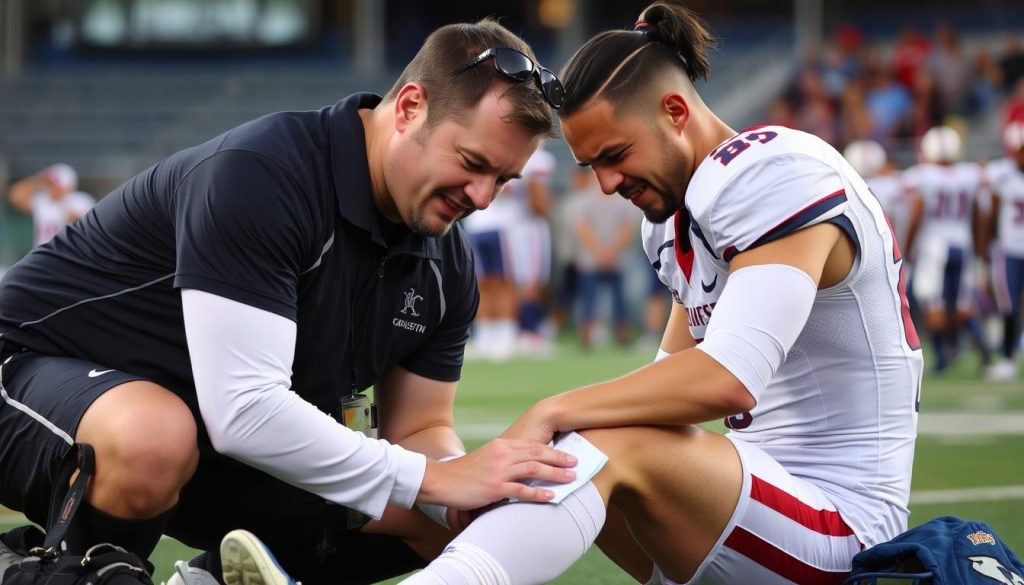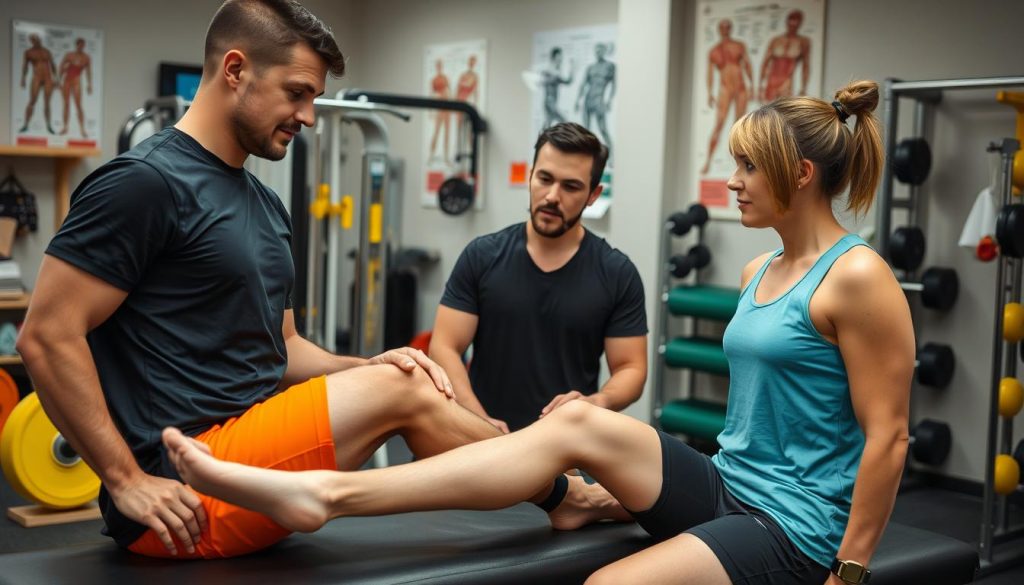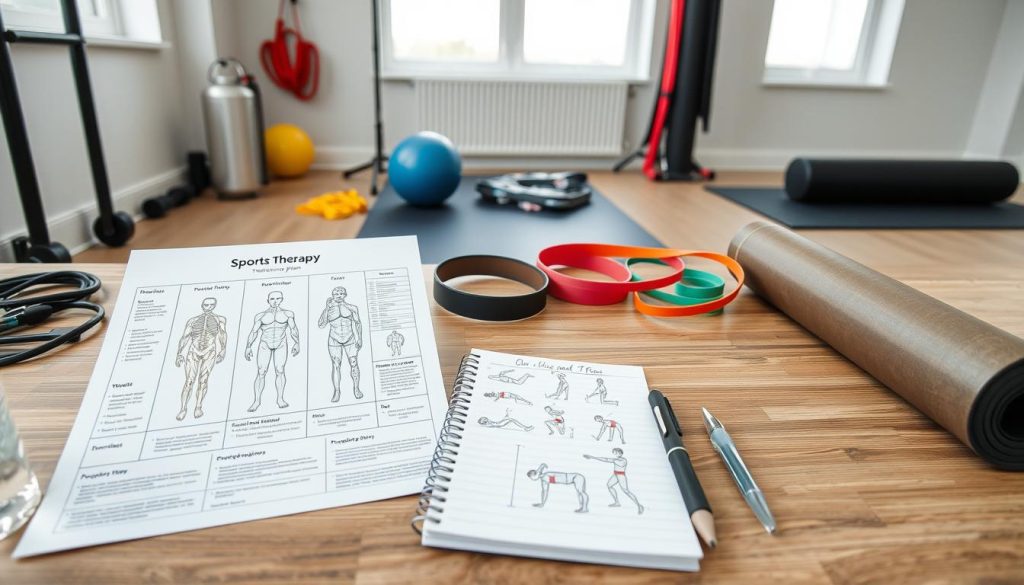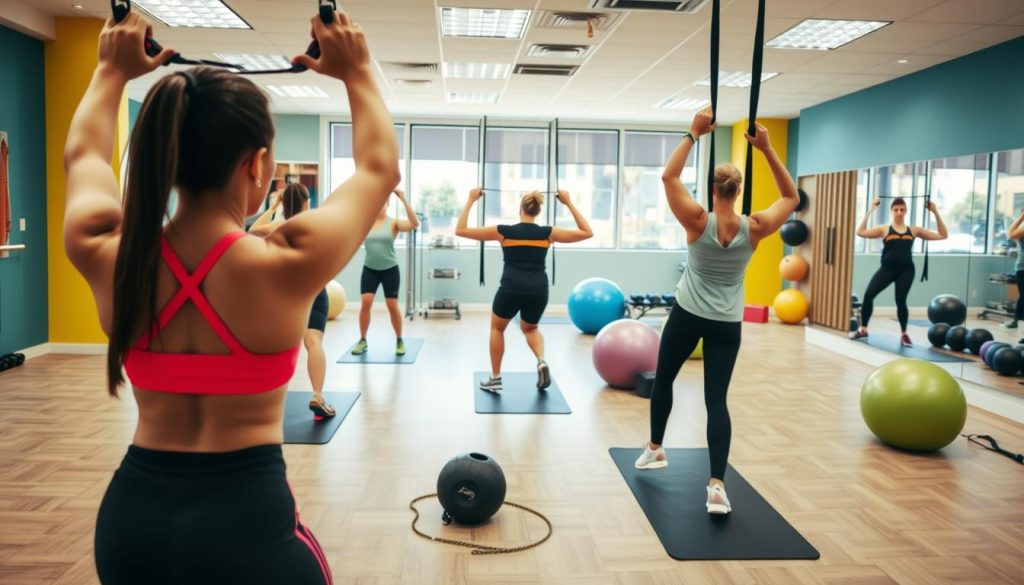Sports therapy is key for healing and getting back to sports for athletes and active people. At Riverside Sports Therapy in Calgary, expert therapists use detailed recovery plans. These plans help restore physical function and performance.
To understand sports therapy’s role in recovery, we must see its wide-ranging approach. It goes beyond usual treatments, focusing on custom rehab. This addresses both the physical and mental sides of healing from injuries.
Athletes in Canada use special sports therapy methods for their recovery. They use advanced tools, specific treatments, and step-by-step rehab plans. This helps them regain strength, move better, and feel confident again after injuries.
Key Takeaways
- Sports therapy provides complete injury recovery solutions
- Personalized treatment approaches speed up healing
- Professional therapists use advanced diagnostic techniques
- Recovery strategies tackle both physical and mental rehab
- Targeted interventions help athletes get back to their game
Understanding Sports Therapy: A Complete Overview
Sports therapy is key in helping athletes perform better and recover from injuries. It uses medical knowledge and special rehab methods to help athletes heal.
Athletes face many physical challenges that need smart recovery plans. Sports therapy is vital for recovery. It offers full care to help athletes get back to their best.
Key Components of Sports Therapy Treatment
- Comprehensive physical assessment
- Individualized treatment planning
- Advanced rehabilitation protocols
- Biomechanical analysis
- Pain management interventions
Role of Sports Therapists in Recovery
Sports therapists are key in helping athletes recover. They use their medical skills and rehab techniques to help athletes with specific injuries.
| Recovery Stage | Sports Therapy Techniques | Primary Objectives |
| Acute Phase | Manual therapy, inflammation reduction | Minimize damage, control pain |
| Rehabilitation Phase | Strength training, mobility exercises | Restore function, rebuild strength |
| Performance Restoration | Sport-specific conditioning | Return to peak athletic performance |
Scientific Principles Behind Sports Therapy
Sports therapy uses science to help athletes recover. It combines understanding of the body, healing, and rehab methods. This helps athletes recover fully.
“Recovery is not just about healing injuries, but restoring an athlete’s confidence and physical capabilities.” – Dr. Sarah Roberts, Sports Medicine Specialist
How Sports Therapy Helps with Post-Injury Recovery
Sports therapy is key in helping athletes recover from injuries. It uses detailed treatment plans to tackle both physical and mental challenges. This approach gives athletes a new chance to heal and regain their strength.
“Recovery is not just about healing physical wounds, but rebuilding an athlete’s confidence and strength.” – Sports Medicine Expert
The journey to recovery through sports therapy includes several important steps:
- Personalized assessment of injury severity
- Customized treatment protocols
- Progressive strength training
- Pain management techniques
- Psychological support
Sports therapists use advanced methods to aid in recovery. Biomechanical analysis and focused interventions help athletes heal faster. This approach also lowers the risk of getting hurt again.
| Recovery Stage | Primary Focus | Duration |
| Acute Phase | Inflammation Reduction | 1-2 Weeks |
| Intermediate Phase | Mobility Restoration | 2-4 Weeks |
| Advanced Phase | Strength Conditioning | 4-8 Weeks |
Every athlete’s path to recovery is different. Sports therapy offers personalized plans for healing. This ensures athletes can return to their best with confidence and strength.
The Immediate Response: First Steps After Sports Injury
When a sports injury happens, the first moments are key for recovery. A good sports therapy program can greatly help. It can reduce long-term damage and speed up healing.

“The first 24-48 hours after an injury are critical for recovery” – Sports Medicine Expert
Initial Assessment and Treatment Planning
Sports therapists do a detailed first check to see how bad the injury is. This important step includes:
- Detailed physical examination
- Range of motion testing
- Pain level documentation
- Functional movement screening
Managing Acute Injury Symptoms
Quickly managing symptoms is key in sports therapy. The usual method is the R.I.C.E. protocol:
| Intervention | Purpose | Duration |
| Rest | Prevent further injury | 24-48 hours |
| Ice | Reduce inflammation | 15-20 minutes |
| Compression | Minimize swelling | Continuous |
| Elevation | Decrease fluid accumulation | Above heart level |
Emergency Care Protocols
Sports therapists follow strict emergency plans to keep patients safe. Important steps are:
- Immediate injury stabilization
- Pain management techniques
- Preventing further tissue damage
- Rapid medical referral if necessary
Quick action can greatly cut down recovery time and avoid long-term issues in sports injury rehab.
Physical Assessment and Diagnostic Techniques in Sports Therapy
Sports therapy uses precise physical checks and diagnostic methods to help athletes recover. Professional sports therapists use advanced techniques to understand athletic injuries. These detailed checks are key to creating effective treatment plans.

- Comprehensive clinical examinations
- Functional movement screening
- Advanced imaging technologies
- Biomechanical analysis
Special tools help sports therapists make recovery plans for each athlete. These methods help find out exactly what’s wrong, so treatments can be tailored.
| Assessment Method | Primary Purpose | Key Diagnostic Insight |
| Musculoskeletal Ultrasound | Soft Tissue Evaluation | Real-time muscle/tendon visualization |
| Functional Movement Screen | Movement Pattern Analysis | Identifying possible injury risks |
| Gait Analysis | Movement Mechanics Assessment | Finding out compensatory movement patterns |
“Accurate diagnosis is the cornerstone of effective sports injury rehabilitation” – Sports Medicine Research Institute
Tools like motion capture systems and 3D biomechanical modeling give deep insights into how athletes move. These methods help sports therapists create detailed, data-based recovery plans.
Customized Treatment Plans: Tailoring Therapy to Individual Needs
In sports therapy, every athlete is different. Each one needs a special plan based on their injury, goals, and needs.

Success in sports therapy comes from a tailored approach. Athletes need care that fits their unique physical and health needs.
Factors Influencing Treatment Approaches
- Type and severity of injury
- Athlete’s sport-specific demands
- Individual physical condition
- Previous medical history
- Age and recovery speed
Progressive Recovery Stages
Recovery has different stages:
- Initial Stabilization: Reducing inflammation and preventing further damage
- Mobility Restoration: Gradual range of motion exercises
- Strength Rebuilding: Targeted muscle conditioning
- Performance Optimization: Sport-specific training
Monitoring and Adjusting Programs
Therapists must keep a close eye on progress. They make changes as needed to keep the recovery on track.
“Personalization is the key to successful sports injury recovery” – Dr. Sarah Thompson, Sports Rehabilitation Specialist
The goal of sports therapy is more than just healing. It’s about getting athletes back to their best, with confidence and less risk of injury.
Advanced Rehabilitation Techniques and Technologies
Sports therapy has changed a lot with new technologies. Now, athletes get better faster thanks to these innovations. They help in healing and make recovery better.
Today, athletes can heal faster than ever before. New technologies offer more than old ways. They focus on the injury’s needs, making recovery more effective.
- Hydrotherapy for low-impact muscle conditioning
- Cryotherapy for inflammation reduction
- Electrotherapy for targeted muscle stimulation
- Biomechanical analysis for movement optimization
Technological innovations have transformed sports therapy from reactive treatment to proactive performance enhancement.
“The future of sports injury recovery lies in integrating advanced technological interventions with personalized rehabilitation strategies.” – Sports Medicine Research Institute
| Technology | Recovery Benefit | Application |
| Ultrasound Therapy | Tissue Healing | Soft Tissue Injuries |
| Laser Treatment | Pain Reduction | Muscle Strains |
| Virtual Reality Rehabilitation | Cognitive-Motor Recovery | Neurological Injuries |
Sports therapy keeps getting better. It now uses artificial intelligence and new tools for recovery plans. This helps therapists make programs that are more precise and effective.
Pain Management Strategies in Sports Therapy
Managing pain is key in sports therapy. Athletes often face tough recovery times. They need smart ways to control pain and heal.
Sports therapy does more than just ease symptoms. It creates detailed plans to handle both physical and mental sides of injury.
Non-Pharmacological Pain Control Methods
Sports therapy uses many non-drug ways to manage pain:
- Manual therapy techniques
- Soft tissue manipulation
- Therapeutic massage
- Trigger point release
- Myofascial techniques
Therapeutic Modalities for Pain Relief
New technologies are big in sports injury care. They help athletes deal with pain:
- Ultrasound therapy
- Transcutaneous Electrical Nerve Stimulation (TENS)
- Cryotherapy
- Heat therapy
- Electromagnetic treatments
“Pain is temporary. Quitting lasts forever.” – Lance Armstrong
Every pain method is picked based on the athlete’s injury and goals. The goal is to make recovery as comfortable as possible.
Sports therapists take a whole-body approach. They treat physical and mental sides of injury. This helps athletes get through tough recovery times.
Strengthening and Conditioning Programs for Recovery
Sports therapy programs help athletes get back in shape after injuries. They focus on building muscle strength and improving endurance. The goal is to make sure athletes can safely play sports again.

Recovery needs a plan of exercises that target specific muscles and movements. These plans are made to fit each athlete’s needs. They also help avoid getting hurt again.
- Muscle Strength Restoration
- Neuromuscular Coordination Training
- Progressive Resistance Exercises
- Sport-Specific Conditioning
“Successful rehabilitation is about quality movement, not quantity of repetitions.” – Professional Sports Therapist
Recovery through sports therapy involves several important steps:
| Recovery Stage | Primary Focus | Key Objectives |
| Initial Phase | Mobility Restoration | Reduce Stiffness, Increase Range of Motion |
| Intermediate Phase | Strength Building | Muscle Rebuilding, Stability Enhancement |
| Advanced Phase | Performance Conditioning | Sport-Specific Skill Reintegration |
Personalized assessment and continuous monitoring are key to a good sports therapy program for recovery.
Range of Motion and Flexibility Restoration
Sports therapy is key in helping athletes get back to their best. It focuses on improving flexibility and range of motion. These are vital for a full recovery and getting back to top performance.
Good sports therapy does more than just heal injuries. It works on making joints and muscles flexible again. This way, athletes can reach their full strength after an injury.
Progressive Mobility Exercises
Recovering athletes need special exercises that get harder as they get better. These exercises help:
- Reduce stiffness in affected joints
- Improve muscle elasticity
- Restore natural movement patterns
- Prevent compensatory movements
Joint Function Optimization
Getting joints to work right again needs a smart plan. It’s all about what each athlete needs:
| Technique | Primary Goal | Typical Duration |
| Passive Range of Motion | Maintain joint mobility | 1-2 weeks |
| Active-Assisted Exercises | Gradual strength rebuilding | 2-4 weeks |
| Progressive Resistance Training | Complete functional restoration | 4-8 weeks |
“Flexibility is not just about stretching, but about intelligent, progressive rehabilitation.” – Sports Medicine Professional
It’s important to watch athletes closely and tailor treatment plans. This ensures they can safely get back to playing.
Psychological Aspects of Injury Recovery

Injury recovery in sports therapy is more than just fixing the body. The mind also needs healing. Sports therapy knows that a healthy mind is key to getting back to top form.
Athletes face big emotional challenges when they’re hurt. Sports therapy helps tackle these mental hurdles:
- Managing performance anxiety
- Overcoming fear of re-injury
- Maintaining motivation during rehabilitation
- Developing mental resilience
Psychological support becomes a critical intervention strategy. Sports therapists use many methods to help athletes overcome emotional obstacles:
- Cognitive behavioral strategies
- Visualization techniques
- Goal-setting workshops
- Stress management training
“Recovery is 90% mental and 10% physical” – Unknown Athletic Trainer
Professional athletes know that mental toughness helps the body heal faster. Sports therapy combines mental counseling with physical care for a full recovery.
By tackling emotional issues, sports therapists help athletes regain confidence. They learn to manage their expectations and develop ways to cope. This is vital for a successful comeback to their best performance.
Return to Sport: Guidelines and Protocols
Athletes recovering from injuries face a critical phase in their rehabilitation journey. The sports therapy program for post-injury rehabilitation requires careful planning and strategic implementation. This ensures a safe and effective return to athletic performance.
Returning to full athletic activity demands a structured approach. This approach minimizes re-injury risks while rebuilding an athlete’s confidence and physical capabilities. How sports therapy helps with post-injury recovery involves multiple strategic steps. These steps are designed to protect and progressively challenge the athlete’s healing body.
Performance Testing and Assessment
Comprehensive performance evaluation is key in determining an athlete’s readiness to resume sports activities. Key assessment criteria include:
- Muscular strength symmetry
- Range of motion measurements
- Functional movement screenings
- Pain-free movement patterns
“Careful assessment prevents premature return and prevents long-term damage.” – Sports Medicine Expert
Gradual Activity Progression
The sports therapy program for post-injury rehabilitation emphasizes a carefully structured return strategy. Athletes progress through meticulously planned stages. These stages gradually increase intensity and complexity.
- Initial low-impact conditioning
- Sport-specific skill drills
- Controlled resistance training
- Full-contact practice scenarios
Each progression stage requires professional monitoring. This ensures the athlete’s physical and psychological readiness for complete sports participation.
Preventing Re-Injury: Long-Term Management Strategies
Sports therapy does more than just treat injuries. It’s a long-term process for athletes and active people. To avoid getting hurt again, they need a solid plan that goes beyond basic rehab.
Good prevention includes several key steps:
- Regular biomechanical assessments
- Personalized conditioning programs
- Advanced movement screening techniques
- Progressive strength training protocols
“Prevention is always more effective than cure in athletic performance and injury management.” – Sports Medicine Research Institute
Athletes need to work with sports therapists to create a maintenance plan. This plan includes regular checks, specific exercises, and detailed tests. These help spot risks before they turn into big injuries.
Being proactive means knowing your body, fixing muscle imbalances, and staying in top shape. Seeing recovery as a journey, not just a fix, shows the real value of sports therapy.
- Consistent monitoring prevents setbacks
- Individualized strategies lower injury risks
- Comprehensive assessment boosts long-term performance
Long-term success needs commitment, expert advice, and a full view of health. Using advanced sports therapy, athletes can cut injury risks and reach their best physical form.
The Role of Nutrition in Recovery Support
Nutrition is key in injury recovery through sports therapy. Athletes need special diets to help their bodies heal and recover better.
“Food is medicine for athletes undergoing sports therapy techniques for injury recovery” – Sports Nutrition Expert
The right nutrition for injury recovery includes several important parts:
- Reducing inflammation with specific nutrients
- Helping tissues repair and grow
- Keeping muscle mass up when you can’t move much
- Boosting the immune system
Sports therapists work with nutritionists to create custom diets. These diets meet the athlete’s specific needs based on their injury, metabolism, and recovery stage.
| Nutrient | Recovery Benefits | Recommended Sources |
| Protein | Muscle repair and growth | Lean meats, fish, eggs, legumes |
| Omega-3 Fatty Acids | Inflammation reduction | Salmon, chia seeds, walnuts |
| Vitamin C | Collagen production | Citrus fruits, bell peppers |
Good nutrition speeds up healing and helps athletes get back to their best faster during injury recovery through sports therapy.
Conclusion
Sports therapy is a new way to heal and help athletes get back to their best. It uses special techniques and plans made just for each athlete. This helps them get over injuries and perform at their top level again.
The road to recovery is long and needs expert help. Sports therapy does more than just medical care. It uses new rehab methods, exercises, and wellness plans to help athletes at every step.
Riverside Sports Therapy makes plans just for each athlete. Our team uses the latest tech, science, and care to help athletes through tough times. Whether you’re a pro or just play for fun, we’re here to help you get strong and confident again.
Are you ready to start your recovery? Call Riverside Sports Therapy at (403) 283-7551. See how our sports therapy programs can make you stronger than before. Your journey to being your best starts with our expert care and plans made just for you.
For more details, visit: https://www.riversidesportstherapy.com/2025/01/30/manual-therapy-vs-other-sports-therapy-techniques/
For more details, visit: https://www.riversidesportstherapy.com/calgary-contact/
